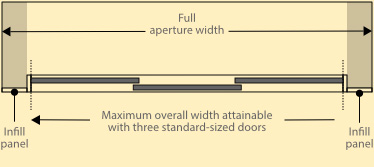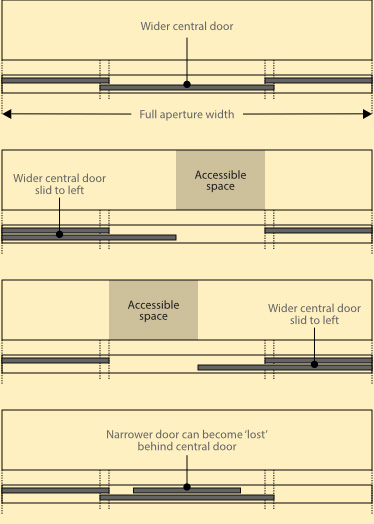REQUIRE A BESPOKE LOOK?
We offer a custom design
service at NO extra cost.
Although the large majority of doors that Wardrobe Doors Direct supplies are to customers’ ‘bespoke' or 'non-standard’ dimensions, we do also offer a range of ‘off-the-shelf’ or ‘standard-size’ sliding wardrobe doors. In this article we look at some of the main advantages and possible drawbacks associated with choosing such doors that are manufactured to a limited range of standard sizes, and discover if they are more or less cost-effective than choosing doors of completely bespoke dimensions.
Standard-size sliding wardrobe doors are generally available in three different widths – 614mm, 764mm and 919mm (but on some of our panel colours we can offer a 1074mm wide door) – and to a standard height of 2250mm. Standard-size sliding wardrobe doors are only available with steel frames and there is usually only a limited number of finishes and colours to choose from.
View our standard-size sliding wardrobe door range here:
It goes without saying that you will find standard-size sliding wardrobe doors available at lower cost than like-for-like size made-to-measure sliding wardrobe doors. There are a number of reasons for this:
It is also important to understand that standard-size doors are produced to a pre-determined price point – within the overall market there is an ‘assumed price’ that a customer will pay for a particular specification of any product and the doors are made to a fixed cost to meet that price, which also allows a margin of profit for the manufacturer. This final fixed cost that needs to be achieved also means that other elements or components that go into the manufacture of the doors will, in turn, need to be sourced or produced to help meet that final cost too. Please refer to our article Comparing our sliding wardrobe doors with other manufacturers’ sliding wardrobe doors.
With standard-size doors that are in stock, collection the same day is usually possible, or if self-collection is not possible, delivery by the supplier may be possible with a nominal delivery charge being added. In contrast, the 3-4 week lead time quoted for fabricating and delivering bespoke-size sliding doors may be the deciding factor for some customers in choosing standard-size doors. However, in our experience, we find that most customers have considered their wardrobe installation project for some time prior to initiating it, and therefore a delivery schedule of this length is not sufficient reason to dissuade them, particularly when they understand that the installation process itself is likely to be much swifter than the additional work associated with making standard-size doors fit their available aperture dimensions. In other words, these customers realise the benefits to be gained from “making the doors to fit the hole rather than making the hole fit the doors.”
We have looked at production costs and how they can be lower compared to the process of fabricating bespoke-size doors but at the point of installation the cost savings are not as clear cut. For example, if you plan to employ a joiner or other tradesperson to install ‘off-the-shelf’ sliding wardrobe doors for you, there will likely be some additional costs relating to materials used and/or time required in order to install the doors satisfactorily.
In most cases, with standard-size doors, the opening or aperture height in which they are to be fitted will need to be reduced. This can be achieved either by creating a bulkhead to bring the height of the ceiling down, or by building a plinth to raise the height of the floor on which to position the bottom tracks.
Similarly, adjustment may also be necessary to compensate for any mismatch between the width of your doors and the overall width of the opening. If your aperture is not quite wide enough to accommodate the closest standard-size doors; or if it is wider than the closest standard-size doors, there will be a level of additional work and/or materials required (in either aperture enlargement or aperture reduction) to ensure the finished installation matches as seamlessly as possible within your room.
So, when considering the choice between using lower-priced standard-size doors or slightly more costly made-to-measure doors, it is important to factor- in any potential additional time/material costs that may be necessary if the former option is chosen.
The time required for the installation of made-to-measure sliding wardrobe doors can therefore, actually be shorter and work out to be more economical. The cost-saving can be even greater if you decide to install the doors yourself – please refer to our comprehensive and easy-to-follow installation guides to better understand this process.
We have seen installations where different width doors have been used to fill the gap on an opening, ie. where doors of the same width would have been either too wide overall, or not wide enough. At first mention, this sounds a workable idea, but in practice it presents a number of problems. Sliding doors of different widths can cause annoying access issues where parts of the wardrobe‘s interior cannot be reached easily, or at all – see the section Mix-and-match door widths to the right. Not maximising the amount of storage space within, or having access to, your new wardrobe’s interior will defeat many of the reasons you decided to install a sliding door wardrobe in the first place! There is also the possibility of the narrower door sliding behind a wider one, rendering it unreachable for closing again!
As potentially you may be opening and closing the doors and accessing the interior storage spaces at least twice a day, over the course of many years, it makes much more sense in our mind to have doors that are not only of an equal width, but that are also of widths selected by you, that correspond to the interior compartment spaces of your wardrobe and its contents.
Although the potential purchase cost of standard-size doors is likely to be less than bespoke, made-to-measure sliding wardrobe doors, we believe the other costs that are likely to be incurred, not only in financial terms but also in terms of time, render them the more cost-effective choice overall.
If you would like to discuss your projects with a Wardrobe Doors Direct team member please ring 0800 035 1730.
Below are examples of some of the issues that you may encounter if deciding to use standard-size doors for your sliding wardrobe installation.
If this is the case then the only practical method to resolve the issue is to allow more overlap between the doors. However, as can been seen in Fig. 1 below, this results in a significant area of the internal space being difficult to access. The areas shaded grey show the interior space that can only be accessed by reaching around the doors when in their open positions. If vertical partitions are present at these points in the interior it would be impossible to access anything that is stored in this area.
Fig 1. Three standard-size doors with large door overlaps

Wardrobe Doors Direct fabricates its doors so there is an overlap of 40mm between doors on steel-framed doors, a 34mm overlap on aluminium-framed doors and a 50mm overlap on our Shaker style doors. This is just enough for the front doors to neatly cover the framework on each door behind but not so much as to restrict access to the interior.
If this is the case then the width of the opening will need to be reduced. This can be achieved by creating boxed-in sections on either side of the wall rebates so as to reduce the overall width – see Fig. 2 below. These infill sections will need to be scribed into the existing wall to make the transition from the wall to the infill panel as neat as possible. As can be seen from the shaded grey areas the interior wardrobe space behind these infill sections can also be harder to access.
Fig 2. Three standard-size doors with infill panels

Attempting to bridge an aperture’s overall width by using doors of differing widths is not recommended. Sliding doors of different widths can present access issues where parts of the wardrobe‘s interior cannot be reached easily, or at all. For example, having a wider central door in a three-door arrangement means that the central section of the interior space can only be accessed by sliding the central door either fully to the right or to the left – see Fig. 3 below. The shaded grey areas illustrate the central space within the wardrobe that can be accessed when the central door is opened to the left or the right. This diagram also illustrates how the narrower doors on the rear track are totally covered by the central door when it is slid open, rendering them impossible to open until the central door is returned to its central position on the front track. The bottom diagram illustrates how either of the narrower doors can easily be ‘lost’ completely behind the central door, rendering them very difficult to close again unless the central door is slid to the left or right to give access to them again – a very frustrating scenario!
Fig 3. Doors of different widths


We offer a custom design
service at NO extra cost.
Follow these simple guidelines to
get the perfect fit for your sliding
wardrobe doors.
The sliding wardrobe doors are
very easy to install so you don’t
have to be a DIY expert.
Request FREE samples to help
with the design process and
colour matching.